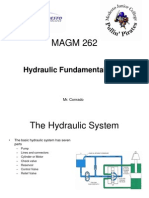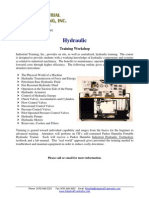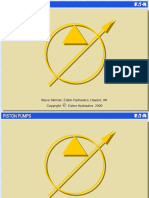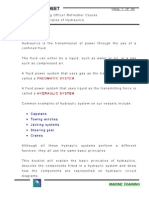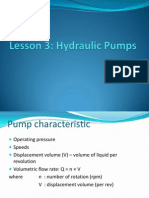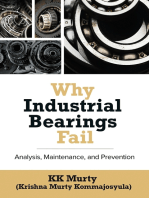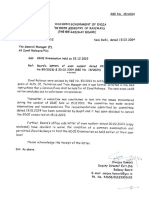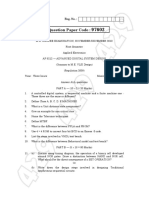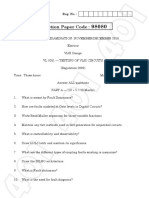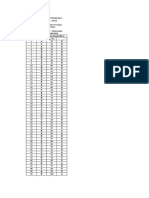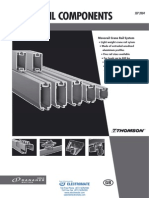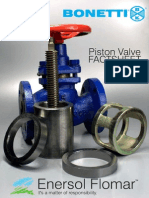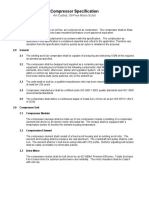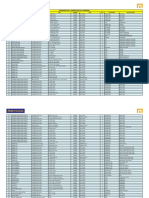Hydraulic Systems
Hydraulic Systems
Uploaded by
ajuklm88Copyright:
Available Formats
Hydraulic Systems
Hydraulic Systems
Uploaded by
ajuklm88Copyright
Available Formats
Share this document
Did you find this document useful?
Is this content inappropriate?
Copyright:
Available Formats
Hydraulic Systems
Hydraulic Systems
Uploaded by
ajuklm88Copyright:
Available Formats
Hydraulics: What
you Need to Know
to Troubleshoot
Ron McGary
TPC Instructor
2
What is Fluid Power?
Fluid Power is the technology that deals with the generation,
control, and transmission of power using pressurized fluids. It
can be said that fluid power is the muscle that moves industry.
This is because fluid power is used to push, pull, regulate, or
drive virtually all the machines of modern industry.
The first hydraulic fluid was water.
IPHYB 201 0418 ©2016 TPC Training
3
What is Fluid Power?
There are actually two different types of fluid systems; Fluid Transport
and fluid power.
Fluid Transport systems have as their sole objective the delivery of a
fluid from one location to another to accomplish some useful purpose.
Fluid Power systems are designed specifically for work.
IPHYB 201 0418 ©2016 TPC Training
4
Hydraulic System Components
What are the 5 basic hydraulic system components?
1. Power Input Device
2. Control Devices
3. Power Output Device
4. Conductors
5. Liquid
IPHYB 201 0418 ©2016 TPC Training
5
Hydraulic System Components
What are the 5 basic hydraulic system components?
1. Power Input Device
Pumps provide power to a hydraulic system by
pumping oil from a reservoir into the supply lines.
2. Control Devices
Valves control direction, pressure, and flow of pressurized oil in
the actuator of the hydraulic system
IPHYB 201 0418 ©2016 TPC Training
6
Hydraulic System Components
What are the 5 basic hydraulic system components?
3. Power Output Device
The power output device is where hydraulic power is
converted into mechanical power. i.e. cylinders and motors.
4. Conductors
Conductors are pipes or hoses needed to transmit liquid
between hydraulic components
5. Liquid
A liquid is used as a medium to transmit the power, i.e. oil
in a reservoir.
IPHYB 201 0418 ©2016 TPC Training
7
Fluid Power System
IPHYB 201 0418 ©2016 TPC Training
8
Fluid Power System
IPHYB 201 0418 ©2016 TPC Training
9
Hydraulic Physics
Maintaining hydraulic systems requires calculations to give
the 21st century maintenance technician a foothold in
determining which pumps and motors to use in their
applications. Don’t worry we will guide you through each
step. Physics involves just about every aspect of our lives,
especially when it comes to the forces that are acting within a
hydraulic system or any other fluid power system, such as
pneumatics.
IPHYB 201 0418 ©2016 TPC Training
www.tpctraining
Instructor Led Training Tpctraining.com
Calculating Horsepower
Horsepower (General): Horsepower (Hydraulic):
DxF QxPx7 QxP
Where: Hp = Where: Hp = QxPx0.000583
Tx550 12,000 1714
Hp is the Power in Horsepower Hp is the Power in Horsepower
D is the Distance in feet Q is the Flow Rate in Gallons Per Minute and
F is the Force in pounds and P is the Pressure in psi
T is the Time in Seconds
Horsepower (Mechanical): Horsepower (Electrical):
Ft xS r ExI
Where: Hp = Where: Hp =
63,025 746
Hp is the Power in Horsepower Hp is the Power in Horsepower
Ft is the Torque in Pound Inches and E is the Electro-Motive Force in Volts and
Sr is the Rotation Speed in Rotations Per Min. I is the Intensity of Current in Amperes (or Amps)
WIPBE 300 1124 © 2021 TPC Training
The Total Training Solution
WIPHYB 301 0421 © 2021 TPC Training The Total Training Solution
11
Pascal’s Law
Pressure is transmitted undiminished in a confined body of
fluid and acts at right angles to all surfaces containing the
confined fluid!
In the 17th century, 1650, Blaise Pascal discovered
a fundamental law of physics which is the basis of
fluid power operation
IPHYB 201 0418 ©2016 TPC Training
12
Basic Formulas
F = PA Where F = Force (in pounds)
A = Area (square inches) F
P = Pressure (PSI)
P A
V = AD Where V = Volume (cu.in.)
D = Distance (movement in inches)
The above formulas can be changed around (by simple algebra)
to give any third factor - if the other two
factors are known.
IPHYB 201 0418 ©2016 TPC Training
13
IPHYB 201 0418 ©2016 TPC Training
14
Terminology
As the FP industry continues to grow and the types and
number of equipment and features also grows… a standard
of terminology became evident.
This standardization is the “glossary of terms” that has
become a common “language” for users of FP.
A copy of this standardization is available from
www.nfpa.com
IPHYB 201 0418 ©2016 TPC Training
15
Directional Control Valves
IPHYB 201 0418 ©2016 TPC Training
16
Basic Hydraulic System
IPHYB 201 0418 ©2016 TPC Training
17
Purpose of Reservoirs
• Serve as heat sink
• Settling area for solids in
fluid
• Positive suction head for
pump
• Provide for secondary
cooling system
• Provide for addition of
fluid
• Indicate fluid level
IPHYB 201 0418 ©2016 TPC Training
18
HI-Lo Pump Control
• Loading of hydraulic
system changes
• Different flow rates
needed
• Low-flow pump
supplies pressure
• High-flow pump
supplies flow
IPHYB 201 0418 ©2016 TPC Training
19
General Symbols
• ISO – Means International Standards Organization
• ANSI – Means American National Standards Institute
• Most graphic symbols are shown in ISO 1219-1976
• The NFPA (National Fluid Power Association (now the IFPA – The
International Fluid power Association) has adopted ISO as it’s
standard.
IPHYB 201 0418 ©2016 TPC Training
20
Lines
IPHYB 201 0418 ©2016 TPC Training
21
Energy Triangles
Pointing out =
PUMP or Compressor
Hydraulic Pump Hydraulic Motor
Pointing in =
MOTOR
Air Pump/Compressor Air Motor
IPHYB 201 0418 ©2016 TPC Training
22
Hydraulic Power Units
IPHYB 201 0418 ©2016 TPC Training
www.tpctraining
www.tpctraining
Instructor Led Training Tpctraining.com
Hydraulic Pumps
TheThe Total Training Solution
WIPBE 300 1124 © 2021 TPC Training
WIPHYB 301 0421 © 2021 TPC Training Total Training Solution
www.tpctraining
Instructor Led Training Tpctraining.com
Hydraulic Pumps
Hydraulic systems require pumps and air systems require compressors to provide
input energy to actuators (such as cylinders and motors).
Understanding pumps & Compressors will give you better knowledge of the
overall operation of the entire system.
We will discuss the basic structure
of: ❑ Positive & variable displacement pumps
WIPBE 300 1124 © 2021 TPC Training
The Total Training Solution
WIPHYB 301 0421 © 2021 TPC Training The Total Training Solution
25
Important!
Pumps Do Not Make Pressure!
When I discuss pumps making pressure it ALWAYS
assumes there is sufficient resistance downstream of
pump
• Resistance to flow allows pressure to build in the system
• As pressure builds – flow tends to slow
• When the restriction is removed or decreased –
• Flow tends to increase
• As a consequence, if the flow AND pressure must be
maintained ……
• More horsepower must be applied
IPHYB 201 0418 ©2016 TPC Training
26
PUMPS
THE HEART OF THE SYSTEM
Hydraulic systems require pumps and air systems require
compressors to provide input energy to actuators (such as
cylinders and motors).
Understanding pumps & Compressors will give you better
knowledge of the overall operation of the entire system.
We will discuss the basic structure of:
Positive & variable displacement pumps
Such as:
IPHYB 201 0418 ©2016 TPC Training
www.tpctraining
Instructor Led Training Tpctraining.com
Hydraulic Pumps
Pumps come in various types and styles.
Hydrodynamic - Non-Positive displacement
Resistance is usually just the weight of the fluid or resistance in the pipe.
WIPBE 300 1124 © 2021 TPC Training
The Total Training Solution
WIPHYB 301 0421 © 2021 TPC Training The Total Training Solution
www.tpctraining
Instructor Led Training Tpctraining.com
Hydraulic Pumps
External Gear Pumps
WIPBE 300 1124 © 2021 TPC Training
The Total Training Solution
WIPHYB 301 0421 © 2021 TPC Training The Total Training Solution
www.tpctraining
Instructor Led Training Tpctraining.com
Hydraulic Pumps
Internal Gear Pumps
WIPBE 300 1124 © 2021 TPC Training
The Total Training Solution
WIPHYB 301 0421 © 2021 TPC Training The Total Training Solution
30
Power Unit Start-Up
1. Fill pump with filtered fluid
2. Fill pump casing
3. Ensure lowest pressure setting
4. Start and stop system while venting
5. Adjust output pressure to system requirements
6. Run pump unloaded
7. Check for leaks
8. Observe reservoir temperature
IPHYB 201 0418 ©2016 TPC Training
31
Power Unit Start-Up
1. Fill pump with filtered fluid
2. Fill pump casing
3. Ensure lowest pressure setting
4. Start and stop system while venting
5. Adjust output pressure to system requirements
6. Run pump unloaded
7. Check for leaks
8. Observe reservoir temperature
IPHYB 201 0418 ©2016 TPC Training
32
Cleaning a Hydraulic System
1. Drain entire system into reservoir
2. Drain reservoir and use off-line filter
3. Replace all filters
4. Clean pump suction strainers
5. Clean reservoir and dry
6. Paint reservoir
IPHYB 201 0418 ©2016 TPC Training
33
Cleaning a Hydraulic System
7. Close reservoir and refill
8. Replace air breather
9. Restart system and take fluid sample
10.Consider adding more filters
11.Follow suggestions to meet cleanliness
levels
IPHYB 201 0418 ©2016 TPC Training
34
Valve Maintenance
• Silting
• Accumulation of fine particles in valve
• Valves operate erratically, partially, or stop
• Varnishing
• Hard coating from breakdown of fluid
• Increase diameters, reduce clearances
IPHYB 201 0418 ©2016 TPC Training
35
Fluid power deals with the transmission and
control of energy by a pressurized
__________.
A. vessel
B. Directional
control valve
C. Electric motor
D.fluid
IPHYB 201 0418 ©2016 TPC Training
36
Pressure is equal to force divided by
__________.
A. weight
B. liquid
C. gas
D.area
IPHYB 201 0418 ©2016 TPC Training
37
The spool of a directional control valve is
shifted to different positions by the
__________.
A. fluid
B. operator
C. conductor
D.cylinder
IPHYB 201 0418 ©2016 TPC Training
38
Cylinder Cross Section
IPHYB 201 0418 ©2016 TPC Training
39
SAFETY
• Oil leaks pose a safety hazard.
• Difficult to quantify – unless someone gets hurt.
• The danger of fire or worse.
• If you have multiple pieces of hydraulic equipment each with
several leaks, the cumulative costs over and
extended period of time is ALARMING.
IPHYB 201 0418 ©2016 TPC Training
40
Maintenance
Would you even think of letting your car go for 100K miles without an
oil change, checking brakes, flushing the radiator, transmission
check-up or the like?
OF COURSE NOT! WHY NOT?
It is amazing that people will only give their hydraulic equipment a
modicum of attention
UNTIL IT STOPS!
Oil needs to be checked for cleanliness and temperature
The oil needs to be changed or maintained
Maintenance REDUCES troubleshooting
IPHYB 201 0418 ©2016 TPC Training
41
A Word About Maintenance
Proper maintenance is one of the most important and yet most
overlooked requirement of a hydraulic system
Too often systems are put into operation and no further
maintenance is performed until a major breakdown occurs
Components in a hydraulic (or pneumatic) system – are
designed to do a specific job under certain (and specific)
operating conditions such as :
Pressure Load Voltage
If conditions are maintained, checked and controlled - all
other components and the entire system will have a
significantly longer service life.
Without maintenance, costly down-time occurs requiring
many troubleshooting hours (and dollars)
IPHYB 201 0418 ©2016 TPC Training
42
Troubleshooting
As with maintenance the common thread that ties failures of
hydraulic systems together is CONTAMINATION.
As long as we know that contamination is the greatest cause of
system failures; “WE NEED TO CLEAN IT UP”
If we could keep our oil clean and cool – we would never
need to change it
What causes the wear? Particulate!
If there were absolutely no particulate - there would be no
abrasive wear.
WE CANT!
IPHYB 201 0418 ©2016 TPC Training
43
Pump Bearing Contamination
• This is the bearing
• That scored the shaft
• That seized the pump
• That shut down the process
• That depleted the inventory
• That couldn’t fill the orders
• That lost the customers
• That tanked the stock price
IPHYB 201 0418 ©2016 TPC Training
44
Fluid Contamination
IPHYB 201 0418 ©2016 TPC Training
45
IPHYB 201 0418 ©2016 TPC Training
46
Gruesome? Yes! & Unnecessary!
IPHYB 201 0418 ©2016 TPC Training
47
5 minute Pre-work Safety Checklist
I am wearing my safety glasses
I have PERSONALLY locked out and tagged out the
electric motor circuit and/or disconnected the battery.
I have PERSONALLY locked out and tagged out the
directional control valve circuit.
I have PERSONALLY depressurized and verified the
hydraulic pressure.
I have PERSONALLY installed mechanical locks or
blocks where necessary.
IPHYB 201 0418 ©2016 TPC Training
48
Troubleshooting Power Units
DIRTY OIL
• Components not properly cleaned after servicing
• Inadequate screening in fill pipe
• Air breather left off – environment sucked in
• Tank not properly gasketed
• Pipe lines left open during servicing
• Baffles do not allow for oil settling in tank
• Filter elements dirty – not replaced often enough
IPHYB 201 0418 ©2016 TPC Training
49
Thank You!
• If you’d like to learn more about hydraulic
systems, TPC can help!
Email: sales@tpctraining.com
Phone: (847) 808-4000
IPHYB 201 0418 ©2016 TPC Training
You might also like
- RYCO Hydraulics Product Technical Manual RHY-RHC0707AUSDocument444 pagesRYCO Hydraulics Product Technical Manual RHY-RHC0707AUSAdiya PurevjavNo ratings yet
- CATERPILLAR CAT D8R TRACK-TYPE TRACTOR Parts Catalog ManualDocument20 pagesCATERPILLAR CAT D8R TRACK-TYPE TRACTOR Parts Catalog Manualshakhko100% (2)
- 07 Donaldson HPK04 Series Data SheetsDocument4 pages07 Donaldson HPK04 Series Data SheetsCarlos Mauricio RodríguezNo ratings yet
- Excercise Fluid Power Control NPTELDocument1,164 pagesExcercise Fluid Power Control NPTELTrần Hoàng VủNo ratings yet
- ZU BombaDocument105 pagesZU BombaErwin CastroNo ratings yet
- 5 117final PDFDocument368 pages5 117final PDFAlex Renne Chambi100% (5)
- GD705-5 Parts Book Fen04875-00-Ma4-1Document666 pagesGD705-5 Parts Book Fen04875-00-Ma4-1dani100% (7)
- Basics of Strength of MaterialDocument45 pagesBasics of Strength of MaterialGaurav ChopraNo ratings yet
- Industrial Automation: BITS Pilani, Pilani CampusDocument132 pagesIndustrial Automation: BITS Pilani, Pilani CampusAnurag RanjanNo ratings yet
- Hydraulic Basics - Doc 2Document164 pagesHydraulic Basics - Doc 2Paul de CastroNo ratings yet
- Hydrualics Design DataDocument2 pagesHydrualics Design DataKeith AdminNo ratings yet
- Hydraulics 4 PDFDocument25 pagesHydraulics 4 PDFVenkat KrishnaNo ratings yet
- Hydraulic Training Smiley PDFDocument100 pagesHydraulic Training Smiley PDFliu zhao liu zhao100% (1)
- Immediate download A Student s Guide to Laplace Transforms Student s Guides Daniel Fleisch ebooks 2024Document50 pagesImmediate download A Student s Guide to Laplace Transforms Student s Guides Daniel Fleisch ebooks 2024fraviacactio100% (3)
- Abmaxx Large Modular HPU: Technical InformationDocument16 pagesAbmaxx Large Modular HPU: Technical InformationHanzil HakeemNo ratings yet
- Caterpillar ReusableDocument2 pagesCaterpillar ReusabletechnourNo ratings yet
- Tele HandlersDocument13 pagesTele HandlersManuel Vizcarra100% (1)
- Morgan SiemensVAI LubricationDocument45 pagesMorgan SiemensVAI LubricationRamesh Timmanagoudar100% (2)
- Turolla Hydraulic Gear Pumps Group3 Catalogue en l1016456Document32 pagesTurolla Hydraulic Gear Pumps Group3 Catalogue en l1016456Gerardo MalpiediNo ratings yet
- Hydraulics Excavator PDFDocument16 pagesHydraulics Excavator PDFChandaKunda100% (1)
- Fluid Power System Investigation Case StudyDocument101 pagesFluid Power System Investigation Case StudyMugilan Mohan100% (1)
- 02.hydraulic Cylinder - EN - LDocument95 pages02.hydraulic Cylinder - EN - Lkurnia triwijayaNo ratings yet
- Hydraulic FundamentalsDocument17 pagesHydraulic FundamentalsRoyal Ritesh SharmaNo ratings yet
- ActuatorsDocument17 pagesActuatorsGururaj GadadNo ratings yet
- Lecture 1.1 - PumpDocument75 pagesLecture 1.1 - Pumpsambat.basnet96No ratings yet
- Industrial Hydraulics TrainingDocument1 pageIndustrial Hydraulics TrainingDharma KusumahNo ratings yet
- Fluid Power With Applications 7th Edition - Chapter 1Document53 pagesFluid Power With Applications 7th Edition - Chapter 1Nadeem AldwaimaNo ratings yet
- Piston PumpsDocument64 pagesPiston Pumpsbatuhan kılıç100% (1)
- ValveDocument136 pagesValveRAVI kayjayNo ratings yet
- Basics of Hydraulics Revision CourseDocument79 pagesBasics of Hydraulics Revision CourseAhmadA.SwidanNo ratings yet
- T05 CIH Hydrostatic TransmissionsDocument39 pagesT05 CIH Hydrostatic TransmissionsMohamed Bakheet100% (1)
- CityPump CP 31361 USDocument5 pagesCityPump CP 31361 USJonathan Guzmán MendozaNo ratings yet
- Noise in HydraulicDocument7 pagesNoise in HydraulicCarlosNo ratings yet
- SWMDocument24 pagesSWMRaj DhuriNo ratings yet
- Basic Hydraulics: Prepared By: Vivekananda - VegeDocument54 pagesBasic Hydraulics: Prepared By: Vivekananda - Vegemdhyderali100% (2)
- Counterbalance Valve Circuits Hydraulics & Pneumatics1Document5 pagesCounterbalance Valve Circuits Hydraulics & Pneumatics1Abdelghani ZitouniNo ratings yet
- Track Master: Festoon SystemsDocument32 pagesTrack Master: Festoon SystemsRenwick69No ratings yet
- Volume6 Hydraulic Seals Fluid Conductor and Hydraulic OilDocument64 pagesVolume6 Hydraulic Seals Fluid Conductor and Hydraulic Oillink2u_007100% (1)
- Basic Hydraulic Systems ComponentsDocument67 pagesBasic Hydraulic Systems Componentssba98No ratings yet
- Hyd TrainingDocument72 pagesHyd TrainingJuned Hamid KhanNo ratings yet
- Unit - IV Hydraulics and PneumaticsDocument26 pagesUnit - IV Hydraulics and PneumaticsRavindra_1202No ratings yet
- Sinhgad College of Engineering, Pune Department of Mechanical EngineeringDocument16 pagesSinhgad College of Engineering, Pune Department of Mechanical EngineeringDrive CNLNo ratings yet
- Hydraulic Pumps IIDocument60 pagesHydraulic Pumps IIDeepak Dani100% (1)
- Parker - General TechnicalDocument34 pagesParker - General TechnicalClarence Smith100% (1)
- 9886A Circuit RecommendataionsDocument34 pages9886A Circuit Recommendataionsbee140676No ratings yet
- Hydraulic System Design, Selection and MaintenanceDocument3 pagesHydraulic System Design, Selection and MaintenanceThabangNo ratings yet
- Hydrostatic Transmissions For Heavy AutovehiculesDocument128 pagesHydrostatic Transmissions For Heavy Autovehicules113BOANo ratings yet
- 10 Mpa Single Acting Uniform Speed Rod Action 2-Stage Telescopic CylindersDocument10 pages10 Mpa Single Acting Uniform Speed Rod Action 2-Stage Telescopic CylindersĐen BáoNo ratings yet
- Hydraulic Pumps and ValvesDocument28 pagesHydraulic Pumps and ValvesIqbal JafarNo ratings yet
- CatalogueTroubleshooting HY29 0022 UKDocument62 pagesCatalogueTroubleshooting HY29 0022 UKStroia Constantin MariusNo ratings yet
- Radicon Series M InchDocument94 pagesRadicon Series M InchdilipNo ratings yet
- Design and Optimation of Arm ExcavatorDocument6 pagesDesign and Optimation of Arm Excavatoranon_664850107No ratings yet
- Deği̇şken Deplasmanli Pi̇stonlu PompaDocument97 pagesDeği̇şken Deplasmanli Pi̇stonlu Pompabatuhan kılıç100% (1)
- WorkshopDocument79 pagesWorkshopGaurav JunezaNo ratings yet
- Hydraulic Actuator 2003Document22 pagesHydraulic Actuator 2003Mohsin Abdul RazzaqNo ratings yet
- H02 Hydraulic CylinderDocument21 pagesH02 Hydraulic CylinderYOGESH GOPALNo ratings yet
- Re08026 2008-09 PDFDocument6 pagesRe08026 2008-09 PDFbrunosamaeianNo ratings yet
- Bolt Torque Chart, Team Buick PDFDocument1 pageBolt Torque Chart, Team Buick PDFnate anantathatNo ratings yet
- 1.1 Fluid Power Defined: 1.2 Hydraulics Versus PneumaticsDocument2 pages1.1 Fluid Power Defined: 1.2 Hydraulics Versus Pneumaticsswami061009No ratings yet
- Fluid Mechanics and Fluid PowerDocument218 pagesFluid Mechanics and Fluid Powerkicha15237301No ratings yet
- Fluid Analysis for Mobile Equipment: Condition Monitoring and MaintenanceFrom EverandFluid Analysis for Mobile Equipment: Condition Monitoring and MaintenanceNo ratings yet
- Why Industrial Bearings Fail: Analysis, Maintenance, and PreventionFrom EverandWhy Industrial Bearings Fail: Analysis, Maintenance, and PreventionNo ratings yet
- Cea 2023 2024Document3 pagesCea 2023 2024ajuklm88No ratings yet
- Clarification CEADocument6 pagesClarification CEAajuklm88No ratings yet
- Sale of Bharat Atta & Bharat Rice at Rly Premises - RBDocument2 pagesSale of Bharat Atta & Bharat Rice at Rly Premises - RBajuklm88No ratings yet
- Letter To JCM - 15.03.2024Document1 pageLetter To JCM - 15.03.2024ajuklm88No ratings yet
- CR & CH RegDocument2 pagesCR & CH Regajuklm88No ratings yet
- Question Paper Code:: Reg. No.Document3 pagesQuestion Paper Code:: Reg. No.ajuklm88No ratings yet
- Minutes of The DC-JCM Meeting Held On 15th & 16th February, 2024Document34 pagesMinutes of The DC-JCM Meeting Held On 15th & 16th February, 2024ajuklm88No ratings yet
- GDCE Examination Regards - RB-1Document2 pagesGDCE Examination Regards - RB-1ajuklm88No ratings yet
- Question Paper Code:: Reg. No.Document2 pagesQuestion Paper Code:: Reg. No.ajuklm88No ratings yet
- Question Paper Code:: Reg. No.Document3 pagesQuestion Paper Code:: Reg. No.ajuklm88No ratings yet
- Question Paper CodeDocument3 pagesQuestion Paper Codeajuklm88No ratings yet
- Question Paper Code:: Reg. No.Document2 pagesQuestion Paper Code:: Reg. No.ajuklm88No ratings yet
- Latest WhoDocument6 pagesLatest Whoajuklm88No ratings yet
- Question Paper Code:: Reg. No.Document3 pagesQuestion Paper Code:: Reg. No.ajuklm88No ratings yet
- Last Grade Servants - Exserviceman-NCC/Sainik WelfareDocument1 pageLast Grade Servants - Exserviceman-NCC/Sainik Welfareajuklm88No ratings yet
- Electronic CircuitsDocument1 pageElectronic Circuitsajuklm88No ratings yet
- 003Document1 page003ajuklm88No ratings yet
- Microwave OkDocument58 pagesMicrowave Okajuklm88No ratings yet
- Z 3 YAXUlc C8 B27 BXaDocument2 pagesZ 3 YAXUlc C8 B27 BXaajuklm88No ratings yet
- VHDL Code For 4-Bit RcaDocument2 pagesVHDL Code For 4-Bit Rcaajuklm88No ratings yet
- NGBT: Next-Generation Broadcast Television: Continued Rapid Technical AdvancesDocument4 pagesNGBT: Next-Generation Broadcast Television: Continued Rapid Technical Advancesajuklm88No ratings yet
- Transmission Diagnostic Trouble Codes F343-F348Document2 pagesTransmission Diagnostic Trouble Codes F343-F348Lupin GonzalezNo ratings yet
- Francis Turbine ManualDocument6 pagesFrancis Turbine ManualshubhamNo ratings yet
- System Manual: Moviaxis Multi-Axis Servo InverterDocument756 pagesSystem Manual: Moviaxis Multi-Axis Servo InverterВладимир ДаниловNo ratings yet
- B224 Fusing Unit - Ricoh Model - AP-C1cd - PCDocument6 pagesB224 Fusing Unit - Ricoh Model - AP-C1cd - PCrugaNo ratings yet
- BRP Bee Module 5Document16 pagesBRP Bee Module 5priyaNo ratings yet
- Frick Vibration Guidelines FOR Service PersonnelDocument6 pagesFrick Vibration Guidelines FOR Service PersonneldfmolinaNo ratings yet
- Project Standard Specification: Sewage Pumps 15445 - Page 1/12Document12 pagesProject Standard Specification: Sewage Pumps 15445 - Page 1/12adel rihanaNo ratings yet
- Egs300 (BS) - 6 E100806Document2 pagesEgs300 (BS) - 6 E100806ariwibowoNo ratings yet
- Honda Jazz 1.3 Vtec ChainDocument8 pagesHonda Jazz 1.3 Vtec ChainMshiboniumNo ratings yet
- Rt-138 - A1 Lubricating Oils Data & SpecificationsDocument3 pagesRt-138 - A1 Lubricating Oils Data & Specifications郑开元No ratings yet
- Auxiliary Power Unit: Pilot Reference ManualDocument32 pagesAuxiliary Power Unit: Pilot Reference ManualHoracio Quispe FernandezNo ratings yet
- Results For Dyson VacuumDocument1 pageResults For Dyson VacuummelaniaNo ratings yet
- Thomson Movorail Components CatalogDocument11 pagesThomson Movorail Components CatalogElectromateNo ratings yet
- P1500 Open (N)Document3 pagesP1500 Open (N)Nyoman SuryasaNo ratings yet
- Pump Room Layout-03.09.2021Document1 pagePump Room Layout-03.09.2021Akash ShindeNo ratings yet
- Eci Training Auxiliary HydraulicsDocument156 pagesEci Training Auxiliary HydraulicsBiswanath Lenka100% (5)
- Bonetti Piston Valve FactsheetDocument2 pagesBonetti Piston Valve FactsheetRajivharolikarNo ratings yet
- Topik 2 dcv1044Document129 pagesTopik 2 dcv1044Muhammad Naim bin IshakNo ratings yet
- D - 1 Auliary Boiler DrawingsDocument76 pagesD - 1 Auliary Boiler DrawingsEnrique MonteroNo ratings yet
- Cummins GTA855-C281 FR10531Document3 pagesCummins GTA855-C281 FR10531UN DREE 47100% (2)
- Compressor Specification: Air-Cooled, Oil-Free Mono ScrollDocument3 pagesCompressor Specification: Air-Cooled, Oil-Free Mono ScrollJonathan AmirmadhiNo ratings yet
- Reference-Industrial - IC Cranes - GCC, CIS & PARTIAL EUROPEDocument7 pagesReference-Industrial - IC Cranes - GCC, CIS & PARTIAL EUROPEmatekhanNo ratings yet
- Massey Ferguson MF 260 XTRA TRACTOR (INDIA) Parts Catalogue Manual Instant DownloadDocument23 pagesMassey Ferguson MF 260 XTRA TRACTOR (INDIA) Parts Catalogue Manual Instant Downloadgabeaden26No ratings yet
- Siemens - Basics of DC DrivesDocument85 pagesSiemens - Basics of DC DrivesMuhammad Bilal HussainNo ratings yet
- Attila Victoria (VTF VTG)Document74 pagesAttila Victoria (VTF VTG)Trần Hải PhụngNo ratings yet
- Catalogo Retro Cat 416F2Document579 pagesCatalogo Retro Cat 416F2Mendes Tratores100% (2)
- Power SystemDocument7 pagesPower SystemRebar KakaNo ratings yet






















